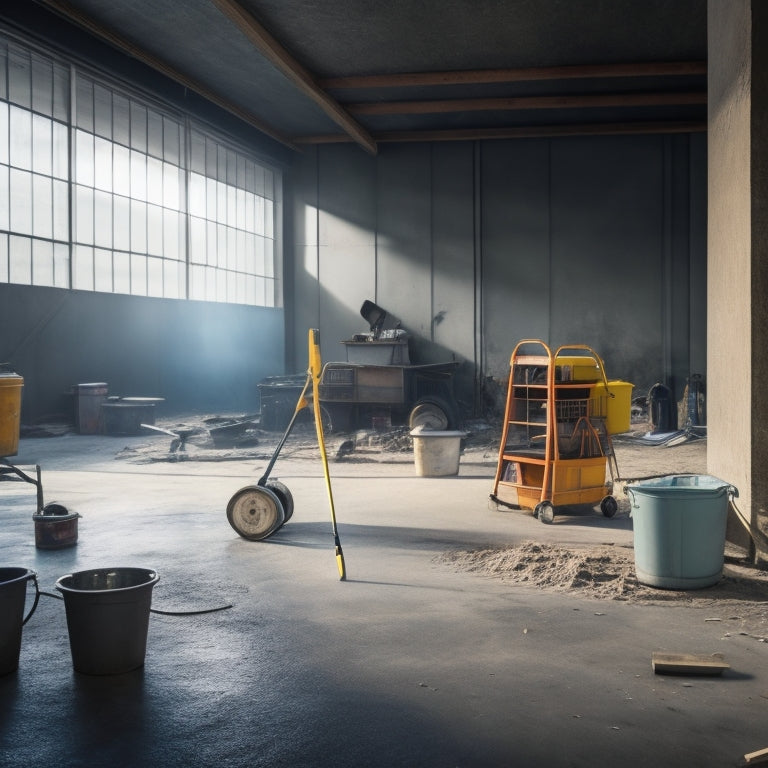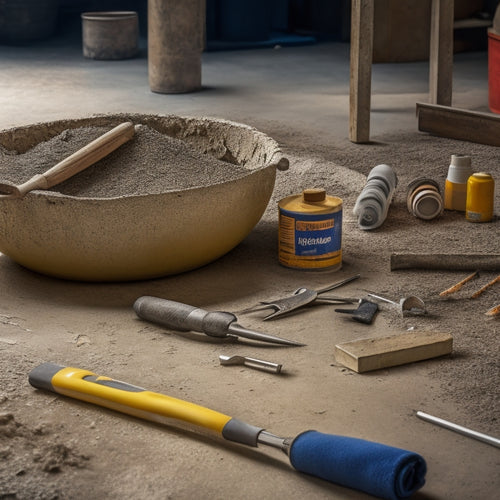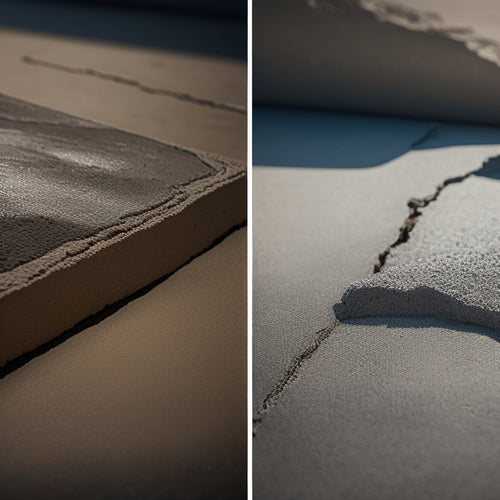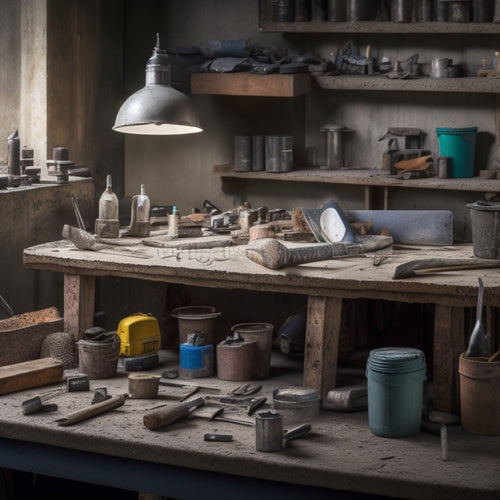
Why Clean Concrete With These Top Tools
Share
When you clean concrete with high-quality tools, you'll achieve a surface that looks brand new. The right broom, such as an angle broom or deck broom, effectively sweeps away debris and dust. For tougher stains, scrubbing tools like wire brushes and scrub brushes come into play. Power washing equipment, including garden hoses and pressure washers, blasts away dirt and grime. By utilizing the right tools and techniques, you'll be able to tackle even the most stubborn stains and imperfections. Now, dive deeper into the world of concrete cleaning and discover the techniques and tools that will take your skills to the next level.
Key Takeaways
• Effective cleaning tools help remove stubborn stains, dirt, and debris, restoring concrete's original appearance and preventing damage.
• Regular cleaning with the right tools prevents the buildup of dirt and stains, reducing the need for heavy maintenance and repairs.
• Using the correct cleaning tools and techniques ensures a safe and environmentally friendly cleaning process, protecting both people and the environment.
• Cleaning concrete with the right tools and techniques helps maintain its durability and extends its lifespan, saving time and resources.
• Proper cleaning and maintenance of concrete surfaces also improve safety by reducing the risk of slips, trips, and falls.
Essential Cleaning Tools for Concrete
You'll need a variety of essential cleaning tools for concrete to effectively remove dirt, grime, and other substances that can compromise the surface. A sturdy broom or push broom is a must-have for sweeping away debris and dust. A garden hose with a spray nozzle is also necessary for rinsing the surface. For tougher stains, you'll need a scrub brush or a stiff-bristled broom. Don't forget a bucket, mild detergent, and warm water for creating a cleaning solution.
When it comes to concrete maintenance tips, it's vital to establish a regular cleaning frequency. Cleaning frequency guidelines recommend daily or weekly sweeping, depending on the amount of foot traffic. For more thorough cleaning, set aside time every 2-3 months to deep clean the surface.
Remember to always test a small area first to confirm the cleaning solution or tool won't damage the concrete. By following these guidelines and using the right tools, you'll be able to maintain a clean and safe concrete surface.
Power Washing for Deep Cleaning
When you're tackling tough concrete cleaning jobs, you'll need to bring in the big guns - specifically, high-pressure water jets that can blast away stubborn dirt and grime.
To get the most out of your power washer, you'll want to experiment with different nozzle angles to find the one that's most effective for your particular job.
High-Pressure Water Jets
High-pressure water jets, also known as power washing, effectively blast away stubborn concrete stains and dirt, making them an ideal method for deep cleaning heavily soiled surfaces. When it comes to tackling tough concrete cleaning jobs, you'll appreciate the benefits of water jet technology, which has revolutionized surface cleaning innovations.
Here are some key advantages of high-pressure water jets:
-
Efficient: High-pressure water jets can clean large areas quickly, making them perfect for commercial or industrial applications.
-
Effective: They can remove even the toughest stains, including oil, grease, and dirt.
-
Versatile: You can adjust the pressure and nozzle angle to tackle various surfaces and cleaning tasks.
-
Cost-effective: High-pressure water jets can reduce labor costs and minimize the need for harsh chemicals.
-
Environmentally friendly: They use only water, making them a more eco-friendly option compared to traditional cleaning methods.
Effective Nozzle Angles
Optimizing nozzle angles is essential for releasing the full potential of power washing, as it enables you to direct the water jet's force precisely where it's needed to dislodge and remove stubborn concrete stains and dirt.
By adjusting the nozzle angle, you can control the width and force of the water stream, allowing you to target specific areas or cover larger surfaces. For example, a narrow fan tip (0-15°) is ideal for pinpointing stubborn stains, while a wider fan tip (25-40°) is better suited for cleaning larger areas.
When selecting a nozzle type, consider the cleaning task at hand. A turbo nozzle, with its concentrated jet stream, is perfect for deep-seated stains and heavy-duty cleaning. On the other hand, a wide-angle nozzle is better for general cleaning and surface preparation.
Mastering effective cleaning angles is also vital. Holding the nozzle at a 45° angle allows for maximum cleaning power, while a shallower angle (20-30°) is better for delicate surfaces.
Wire Brushes for Rough Textures
When you're dealing with rough concrete textures, you'll need to prioritize surface preparation and debris removal.
You'll find that wire brushes are the ideal tool for this task, as they can effectively scrape away stubborn dirt and grime.
Rough Surface Preparation
You'll need to tackle rough textures with wire brushes, which effectively remove loose debris and roughen the surface for a stronger bond. This vital step in surface preparation techniques guarantees a secure foundation for your concrete project. Wire brushes are designed to handle rough surface textures, and their stiff bristles won't damage the concrete.
When preparing rough surfaces, keep the following in mind:
-
Choose the right brush: Select a wire brush with bristles that match the texture of your concrete surface.
-
Work in small sections: Divide your surface into manageable areas to maintain even coverage and avoid missing spots.
-
Apply moderate pressure: Don't press too hard, as this can damage the concrete or dislodge the wire bristles.
-
Brush in a consistent pattern: Use a uniform motion to guarantee an even surface texture.
-
Inspect and repeat: Check your surface regularly and repeat the process as needed to achieve the desired texture.
Aggressive Debris Removal
Relying on wire brushes for aggressive debris removal is vital when tackling rough textures, as they efficiently dislodge and remove loose particles, allowing for a stronger bond between the concrete and subsequent layers.
As you work with wire brushes, you'll encounter various debris types, including dirt, grime, and old coatings, which can compromise the integrity of your concrete surface. By employing the right removal techniques, you can effectively eliminate these obstacles and create a clean slate for your project.
When using wire brushes, it's important to select the appropriate brush type and size for your specific task. For instance, stiff-bristled brushes are ideal for tackling heavy-duty debris, while softer brushes are better suited for more delicate surfaces.
As you work, maintain a consistent angle and apply moderate to heavy pressure, depending on the level of debris present. This will guarantee that you're effectively removing unwanted particles without damaging the underlying concrete.
Acid Etching for Best Adhesion
By acid etching the concrete surface, you create a porous profile that allows coatings or toppings to form a strong mechanical bond. This process involves applying an acid solution to the concrete, which reacts with the calcium hydroxide in the cement paste to create a rough, porous surface. As a result, the coating or topping has a greater surface area to adhere to, reducing the risk of delamination and guaranteeing a long-lasting finish.
When acid etching, it's crucial to:
-
Wear protective gear, including gloves, goggles, and a respirator.
-
Follow the manufacturer's instructions for the acid solution, taking care not to over- or under-etch the surface.
-
Perform surface pH testing to verify the surface is neutralized after etching.
-
Use acid neutralization techniques to remove any remaining acid residue.
-
Thoroughly rinse the surface with water to remove any remaining acid or residue.
Scrub Brushes for Tough Stains
When tackling stubborn stains on your concrete surface, a high-quality scrub brush is crucial for effective removal.
You'll want to choose a brush that's specifically designed for concrete, as it will have the necessary stiffness and abrasiveness to break down tough stains. There are several scrub brush types to evaluate, including wire brushes, nylon brushes, and polypropylene brushes. Each type has its own strengths and weaknesses, so it's vital to select the right one for the job.
For example, wire brushes are great for removing heavy oil and grease stains, while nylon brushes are better suited for lighter stains and more delicate surfaces. Polypropylene brushes, on the other hand, are ideal for removing stubborn dirt and grime.
When using your scrub brush, be sure to work in small circular motions, applying moderate to heavy pressure depending on the severity of the stain. Don't forget to use the appropriate stain removal techniques, such as applying a cleaning solution or degreaser before scrubbing.
Pressure Washer Accessories Needed
Equipping your pressure washer with the right accessories is essential to tackling tough concrete cleaning tasks efficiently and effectively. You'll be able to tackle stubborn stains, grime, and dirt with ease, and guarantee your pressure washer stays in top condition.
Here are the must-have pressure washer accessories you need:
-
Wide fan tip: for covering large areas quickly and evenly
-
Narrow fan tip: for getting into tight spaces and corners
-
Rotary nozzle: for intense cleaning power and precision
-
Detergent injector: for applying the right amount of cleaning solution
-
Hose reel: for convenient storage and reduced kinking
Broom and Dustpan for Debris
You'll want to sweep away loose debris with a sturdy broom and dustpan before firing up your pressure washer to guarantee a more effective and efficient cleaning process. This vital step guarantees that your pressure washer can focus on tackling tough stains and grime, rather than just moving around debris.
When selecting a broom, consider the type of bristles and handle material. For concrete cleaning, a broom with stiff bristles and a durable handle is ideal. You can choose from various broom types, including push brooms, angle brooms, and deck brooms.
| Broom Type | Description |
|---|---|
| Push Broom | Wide, flat head for large areas |
| Angle Broom | Angled head for corners and edges |
| Deck Broom | Stiff bristles for heavy-duty cleaning |
| Soft Bristle Broom | Gentle on surfaces, for light cleaning |
| Whisk Broom | Compact, for small areas and details |
For your dustpan, look for durable materials like metal or heavy-duty plastic. A rubber edge can help with smooth, even collection of debris. By using the right broom and dustpan combination, you'll be able to effectively remove loose debris and prepare your concrete surface for a deeper clean.
Chemical Cleaners for Oil Stains
When tackling oil stains on your concrete tools, you'll need to accurately identify the type of stain you're dealing with, as this will inform your approach to removal.
You'll want to select a chemical cleaner that's specifically designed to target the type of oil or substance that's causing the stain.
Stain Identification Matters
By correctly identifying the type of stain on your concrete surface, you can choose the most effective chemical cleaner to tackle oil-based stains. Understanding the characteristics of different stain types is essential in selecting the right cleaner. Oil-based stains, in particular, can be challenging to remove, but knowing their color impact can help you make an informed decision.
Here are some common oil-based stain types to look out for:
-
Dark brown or black stains: Typically indicate a heavy oil or grease buildup, often requiring a strong solvent-based cleaner.
-
Grey or blue-grey stains: May suggest a lighter oil or petroleum-based substance, which can be removed with a milder cleaner.
-
Red or pink stains: Can indicate the presence of rust or iron oxide, requiring a cleaner specifically designed to target these substances.
-
Yellow or orange stains: Often indicate a mixture of oil and dirt, which may require a combination of cleaning products.
-
Mixed-color stains: May require a multi-step cleaning process, involving a combination of cleaners and techniques.
Effective Remover Selection
With the type of oil-based stain identified, it's time to select a chemical cleaner that can effectively break down and remove the offending substance.
You'll want a cleaner that's specifically designed to tackle oil-based stains, as they're typically more resistant to removal than water-based stains. Look for a cleaner that contains solvents, such as mineral spirits or xylene, which can dissolve and lift the oil out of the concrete.
When selecting a chemical cleaner, consider the type of oil stain you're dealing with. For example, if you're dealing with a petroleum-based stain, you may need a cleaner that's specifically designed to break down hydrocarbons.
Always follow the manufacturer's instructions for application and dwell time to guarantee the cleaner has enough time to penetrate the stain and lift it out of the concrete.
Sandpaper for Smoothening Surface
You'll typically reach for sandpaper with a grit range of 80-120 to smoothen out the concrete surface, removing any minor imperfections. This vital step in surface preparation sets the stage for a successful cleaning process.
As you begin sanding, remember to work in small, circular motions, gradually increasing the pressure as needed. This technique helps prevent scratches and guarantees an even finish.
When it comes to sanding techniques, keep the following tips in mind:
-
Always work with a clean, dry surface to prevent dirt and debris from interfering with the sanding process.
-
Start with a coarser grit and progress to finer grits for a higher level of smoothness.
-
Use a sanding block for larger areas to maintain consistent pressure and prevent uneven wear.
-
Regularly inspect the surface for any remaining imperfections and address them promptly.
-
Avoid applying too much pressure, which can lead to scratches or swirl marks.
Micro-Tamping for Even Finish
After achieving a smooth surface with sandpaper, use micro-tamping to further refine the finish, ensuring an even, compacted layer that's free of air pockets and imperfections.
This process involves using specialized tools to compact and densify the concrete, resulting in a more uniform appearance. To master micro-tamping techniques, start by dividing the surface into sections, and then use a micro-tamping tool to apply gentle, consistent pressure.
Focus on working in small, overlapping circles, gradually increasing the pressure as needed. As you work, pay close attention to surface leveling, ensuring that the concrete is even and flat.
This is essential, as any inconsistencies can lead to a subpar finish. By combining micro-tamping with surface leveling, you'll achieve a flawless, professional-grade finish that's truly exceptional.
Remember to work methodically and patiently, taking the time to thoroughly compact each section before moving on to the next. With practice and attention to detail, you'll be able to achieve stunning results that showcase your mastery of micro-tamping techniques.
Frequently Asked Questions
Can I Use a Household Broom for Cleaning Concrete?
You might think a household broom is sufficient for cleaning concrete, but it's not the most effective tool for the job.
A broom can push dirt and debris around, but it won't provide the necessary scrubbing power to remove tough stains or grime.
For thorough concrete scrubbing, you'll need a more specialized tool that can tackle the tough stuff and leave your concrete looking like new.
How Often Should I Clean My Concrete Surfaces?
Imagine walking on a concrete surface that's as smooth as a freshly polished floor.
You're probably wondering how often you should clean your concrete surfaces to maintain that level of quality. The answer lies in your cleaning frequency.
For high-traffic areas, you should clean daily, while low-traffic areas may only require weekly or bi-weekly cleaning.
Regular surface maintenance is key to preventing dirt buildup and ensuring your concrete stays in top condition.
Are All Concrete Cleaners Environmentally Friendly?
You're right to wonder if all concrete cleaners are environmentally friendly.
The truth is, many cleaners leave behind chemical residues that harm the environment.
However, you can opt for biodegradable cleaners that break down naturally, minimizing their ecological footprint.
When selecting a cleaner, look for certifications like EPA Safer Choice or EcoLogo, which guarantee the product meets stringent environmental standards.
Can I Use a Wire Brush on Smooth Concrete Surfaces?
When tackling smooth concrete surfaces, you're wise to question the wire brush's effectiveness.
While it's great for rough surfaces, it can inflict surface damage on smooth ones. The stiff bristles can scratch or etch the concrete, compromising its appearance and potentially creating a haven for dirt and stains.
Instead, opt for a soft-bristled brush or a non-abrasive cleaning tool to guarantee a gentle, effective clean that preserves the surface's integrity.
Do I Need to Wear Protective Gear While Cleaning Concrete?
When cleaning concrete, you must prioritize your safety. You'll need to wear protective equipment to avoid exposure to harsh chemicals, abrasive particles, and other hazards.
Don't overlook essential safety precautions like gloves, safety glasses, and a dust mask. These will shield you from potential risks, allowing you to focus on the task at hand.
Always put your safety first to guarantee a successful and injury-free cleaning process.
Conclusion
You've made it!
Now, imagine a concrete surface that's sparkling like a diamond, thanks to your new arsenal of cleaning tools.
Picture the Power Washer blasting away dirt like a firehose, the Wire Brush scrubbing rough textures like a determined drill sergeant, and the Acid Etcher prepping for paint like a surgical precisionist.
With these top tools, your concrete is transformed - and so are you, from a DIY novice to a pro who can tackle even the toughest cleaning jobs with confidence.
Related Posts
-

Top Tools for Repairing Cracked Concrete Surfaces
When tackling a cracked concrete surface repair, you'll need the right tools to guarantee a durable fix. Start with e...
-

What Tools Ensure Strong Concrete Adhesion at Home
You'll need the right tools to guarantee strong concrete adhesion at home. For surface preparation, use concrete surf...
-

Top Tools for Concrete Repair Success
When it comes to concrete repair success, you'll need a well-stocked toolkit with essential hand tools like trowels, ...


